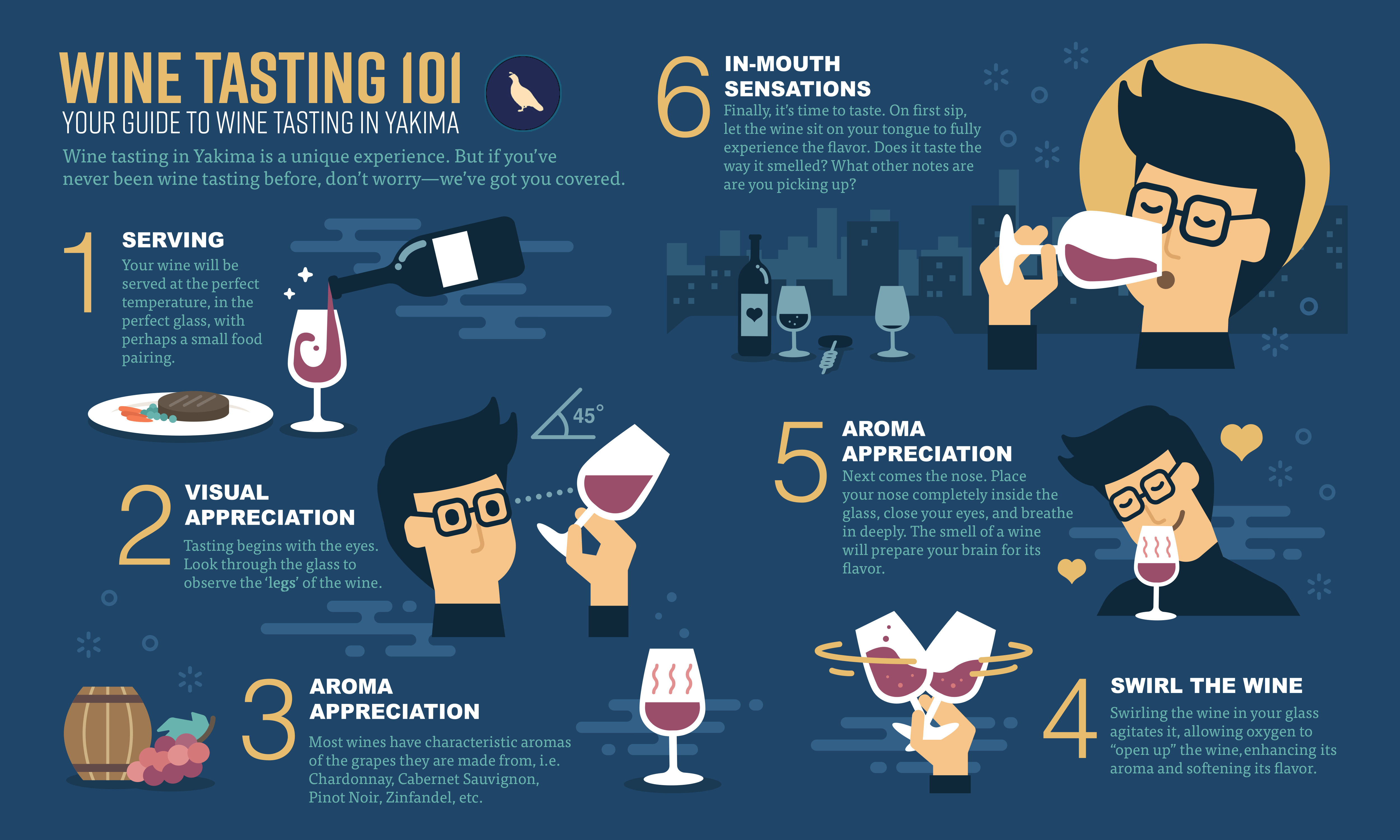
Wine tasting can be a unique experience, even if you aren’t the most knowledgeable wine connoisseur. With all the local and craft wineries in Yakima, wine lovers can really miss an opportunity if they don’t include a few tastings in their plans!
But for those of us who aren’t savvy to the ways of wine, what exactly is a wine tasting? Why attend one? How do I “taste” wine?
It begins with your eyes and nose
Wine tasting isn’t just about drinking wonderful wine. Wine tasting is about learning how to experience the characteristics of wine in other ways—like with sight and smell.
You can follow along with our infographic below!
Serving wine
Your wine will be served in conditions that are appropriate for the wine menu. Some wineries will also pair their tasting menu with a small food item that complements—like a cheese/dried fruit selection to clear your palette. Your wine should be served to you in the appropriate glass and setting that makes for ideal tasting.
Looking at wine
You can tell a lot about wine by its appearance. You’re looking mainly for three things: color, opacity, and viscosity. These things can indicate certain aspects of flavor or a wine’s age. Young wine is typically very dark in color, whereas older wines are a bit lighter. A wine with a very clear quality may have been filtered (in and of itself a controversial aspect of wine).
You can see the “legs” of wine by swirling it (either rotating your wrist gently, keeping the glass upright, or swirling small circles on the table without lifting the glass)—then holding the glass up and observe the wine as its legs move back down the sides of the glass. A wine with a high alcohol content will have thick, slow-moving legs with a dense color. Thick legs can also mean more residual sugar. Thin, quick-moving legs mean low alcohol content and possibly low residual sugar.
The things to look for in wine are seemingly endless, but noting color, clarity, and viscosity are good places to start.
Swirling wine
As noted above, you can swirl wine really any way you like, though two common methods are in small circles on the tabletop, or by rotating your wrist. Either way should be done pretty gently as not to spill wine everywhere, but with enough force to help oxygenate it. Oxygenating the wine will enhance its aroma (important for the next step!). You only need to swirl for a few seconds.
Smelling wine
Smelling wine is just as important as tasting it. It may seem strange, but smelling a glass of wine means getting your nose down in that glass. You want to breathe in deeply and get as good a whiff as you can! The brain can process about 10,000 different smells, and our sense of taste is very heavily influenced by our sense of smell, so the more you can process from smelling wine first, the more you’ll taste once you’re ready to sip.
Note down the first smell that comes to mind—no matter what it is. Tires, fruit, dirty laundry, flowers, your wet dog… whatever you think of first, hold on to it. Common flavor wheels might include things like fruits, nuts, woods, spices, and chemicals, but it’s important to draw and hold on to your own conclusions when smelling wine, as no two people will experience an odor the exact same way. Take a good first whiff, then let your nose rest for about 20 or 30 seconds before going in for a second. Closing your eyes can also help you focus!
Tasting wine
Finally! Though these steps only take two or three minutes in total, we’ve done a lot of prep work to get to taste a glass of wine—but it’ll be worth it. Take one more brief sniff, and then take a good sip—not a gulp. You want a small sip that you can easily swirl around in your mouth. Don’t swish it, but let it rest on your tongue. Some people will move the wine to all parts of their mouths to fully cover their taste buds.
Think about how it smelled—are those notes coming through as you taste it? Does the wine feel light and lifted, or flat? Is the wine dry? Is it sweet, or bitter? Writing down your initial impressions can help you on the second or third sip (unless you’re spitting—see more below)!
Remember to have something to cleanse your pallet between glasses (like that food pairing).
Spitting: If you’re being fairly serious in your wine tasting, or if you’re visiting quite a few tasting rooms in one sitting, you may want to spit your wine out after you’ve sipped (meaning you won’t swallow it; most wineries will have something for you to spit in)—professional wine tasters will rarely ever swallow their wine! This keeps your brain sharp as you continue your tastings, and can also help with flavors of following wines. However, if you’re just tasting for fun, feel free to swallow! Just remember to drink responsibly.
Tasting wine is a treat for those who enjoy wine as a hobby or those who simply like to get together with friends and experience some of the local Yakima culture. Whether you’re beginning your journey as a sommelier or simply looking for a fun Saturday afternoon, Quail Run has you covered! We’re close to all of Yakima’s premier wineries and tasting rooms, and we often host wine-centric events right here at home!



